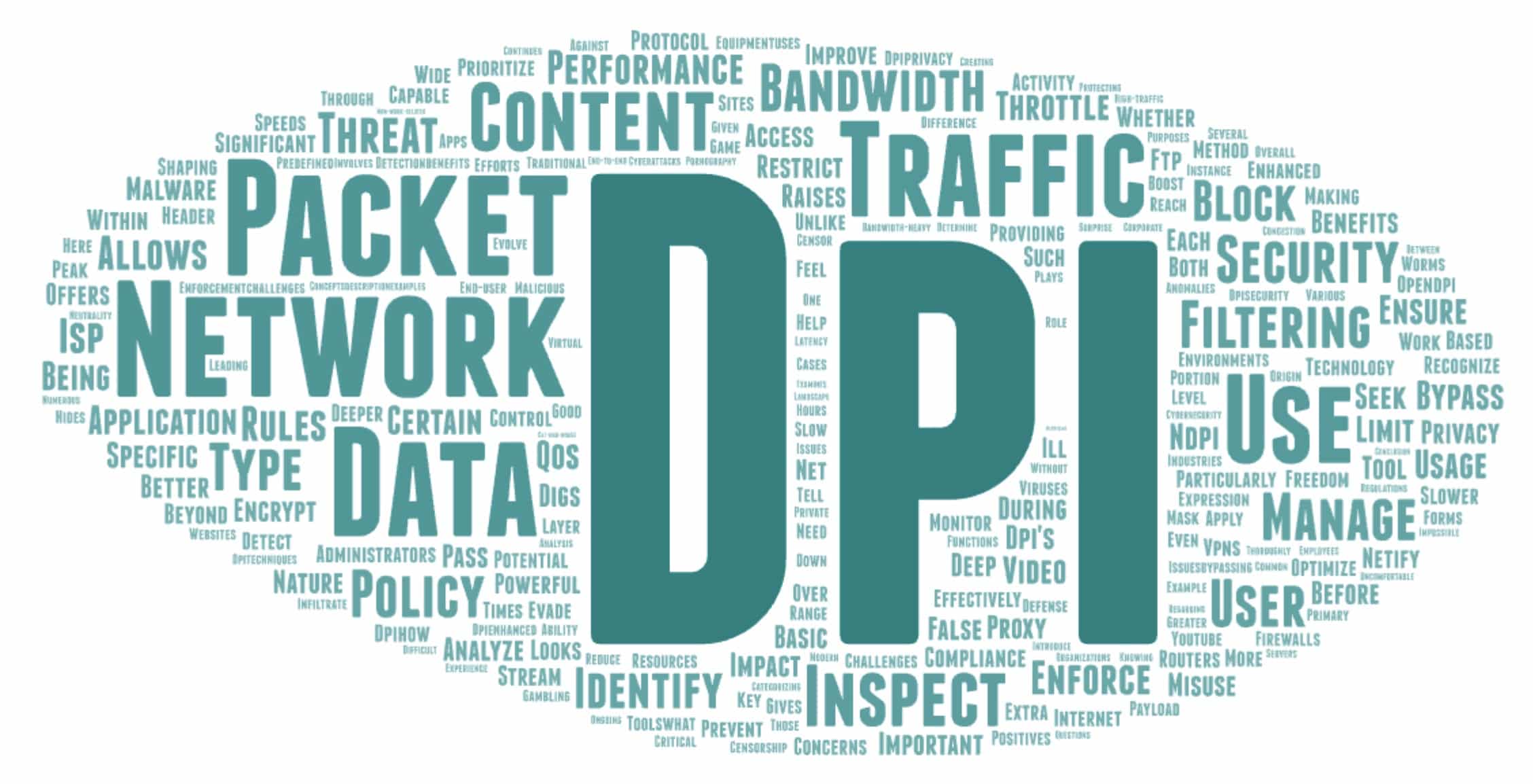
| Key Concepts | Description | Examples/Tools |
|---|---|---|
| What is DPI? | A network packet filtering method that inspects data at a deep level beyond the basic headers. | OpenDPI, nDPI, Netify DPI |
| How DPI Works? | DPI analyzes data packets, identifying their content and applying rules to manage or block them. | Routers, firewalls, ISP equipment |
| Uses of DPI | Security, traffic management, data filtering, policy enforcement, and more. | Network monitoring, traffic shaping, malware detection |
| Benefits of DPI | Enhanced security, better network control, optimized bandwidth usage. | Improved QoS, threat prevention, compliance enforcement |
| Challenges of DPI | Privacy concerns, potential for misuse, performance impact. | Slower internet speeds, false positives, censorship issues |
| Bypassing DPI | Techniques used to evade DPI’s filtering and monitoring capabilities. | VPNs, proxies, encryption tools |
What is DPI?
Deep Packet Inspection (DPI) is a powerful network packet filtering technology that examines the content of data packets as they pass through a network. Unlike traditional packet inspection, which only looks at the packet header, DPI digs deeper into the data portion of the packet, allowing it to identify the nature of the traffic, enforce policies, detect threats, and manage bandwidth more effectively.
How Does DPI Work?
DPI functions by analyzing both the header and the data payload of each packet. This allows it to:
- Identify Protocols and Applications: DPI can recognize what type of application or protocol is being used. Whether it’s HTTP, FTP, or a video stream from YouTube, DPI can tell the difference.
- Enforce Security Policies: By recognizing the type of traffic, DPI can apply rules to block, throttle, or prioritize traffic based on predefined policies.
- Detect and Prevent Threats: DPI is capable of identifying malicious content within packets, such as viruses, worms, or other forms of malware, and can block these threats before they reach the end-user.
Uses of DPI
DPI has a wide range of applications across various industries:
- Security: One of the primary uses of DPI is in enhancing security. By thoroughly inspecting data packets, DPI can detect anomalies and potential threats, providing an extra layer of defense against cyberattacks.
- Traffic Management: ISPs and network administrators use DPI to manage network traffic. By identifying and categorizing traffic, they can prioritize important traffic and throttle bandwidth-heavy applications like video streaming during peak times.
- Data Filtering: DPI allows for the filtering of specific types of content. For instance, organizations can block access to certain websites or types of data (e.g., pornography, gambling sites) to ensure compliance with corporate policies or regulations.
- Policy Enforcement: DPI can enforce policies regarding the use of network resources. For example, it can prevent employees from using bandwidth for non-work-related activities or limit access to specific types of content during work hours.
Benefits of DPI
DPI offers several key benefits:
- Enhanced Security: By inspecting the content of data packets, DPI can identify and block threats before they infiltrate the network, providing a significant boost to cybersecurity efforts.
- Better Network Control: DPI gives network administrators greater control over how network resources are used, allowing them to optimize performance and ensure that critical applications have the bandwidth they need.
- Optimized Bandwidth Usage: By managing traffic more effectively, DPI can help reduce congestion and improve the overall user experience, particularly in environments where bandwidth is limited.
Challenges of DPI
While DPI offers numerous benefits, it is not without its challenges:
- Privacy Concerns: DPI’s ability to inspect data packets raises significant privacy issues. Users may feel uncomfortable knowing that their data is being analyzed, even if it’s for security purposes.
- Potential for Misuse: In some cases, DPI can be used to censor content, monitor user activity, or throttle specific types of traffic, leading to concerns about net neutrality and freedom of expression.
- Performance Impact: Because DPI involves deep analysis of data packets, it can introduce latency and slow down network performance, particularly in high-traffic environments.
Bypassing DPI
Given its capabilities, it’s no surprise that some users seek to bypass DPI, particularly when it’s used to restrict access to certain types of content or throttle bandwidth. Here are some common methods:
- VPNs (Virtual Private Networks): VPNs encrypt all internet traffic, making it impossible for DPI to analyze the packet content. This effectively hides the data from inspection, allowing users to bypass restrictions.
- Proxy Servers: Proxies can mask the origin of traffic, making it difficult for DPI to determine the nature of the data. Proxies can be used to access blocked content or evade throttling.
- Encryption Tools: End-to-end encryption tools, like those used in HTTPS or certain messaging apps, ensure that the data within packets cannot be inspected by DPI, protecting user privacy and bypassing filtering.
Conclusion
Deep Packet Inspection (DPI) is a powerful tool for managing and securing network traffic, but it also raises important questions about privacy, freedom of expression, and network performance. As DPI technology continues to evolve, so too will the methods for bypassing it, creating an ongoing cat-and-mouse game between network administrators and users seeking to evade restrictions. Whether used for good or ill, DPI is an important technology that plays a significant role in the modern internet landscape.







Comments (0)
There are no comments here yet, you can be the first!